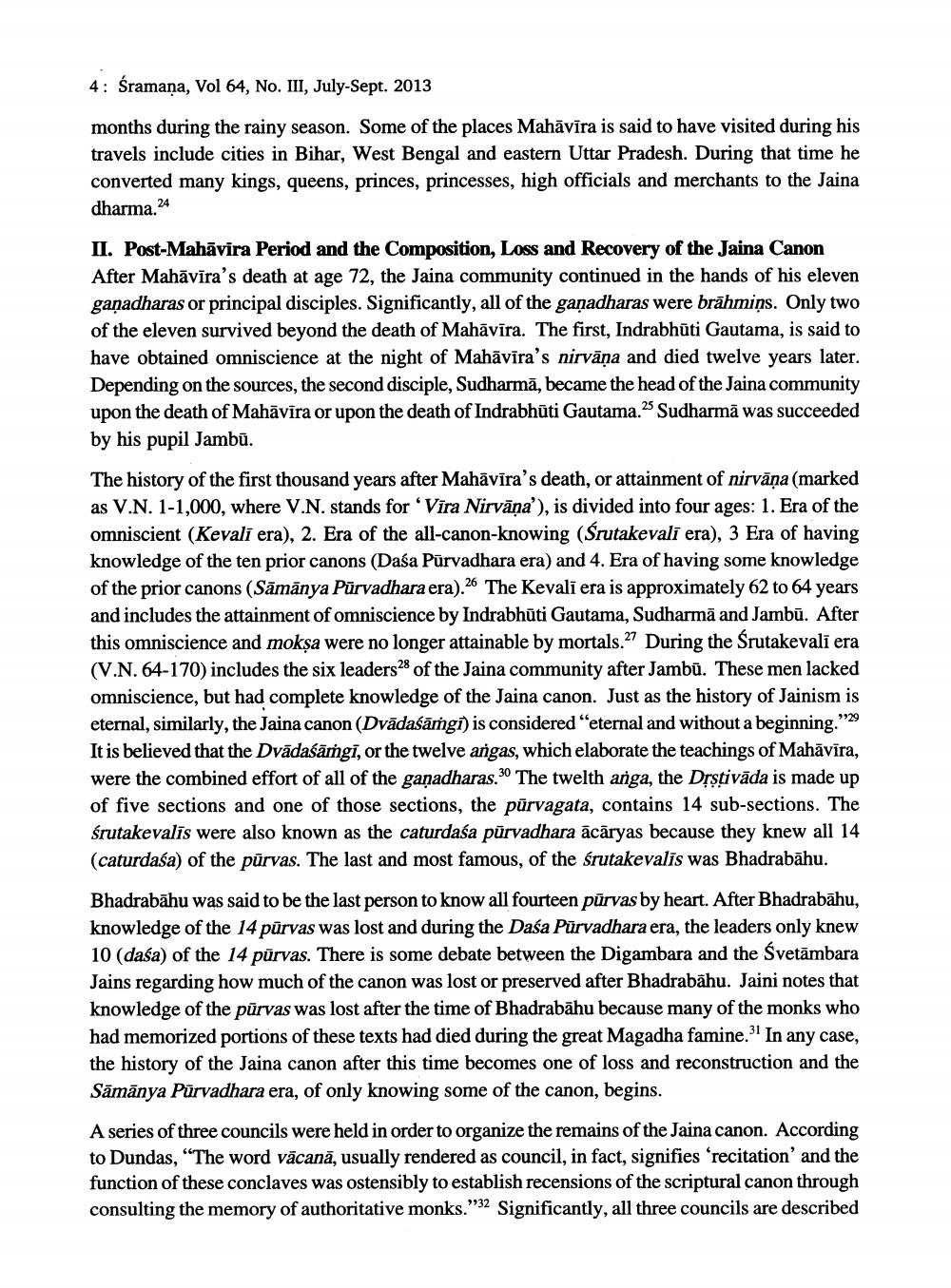________________
4: śramaņa, Vol 64, No. III, July-Sept. 2013 months during the rainy season. Some of the places Mahāvīra is said to have visited during his travels include cities in Bihar, West Bengal and eastern Uttar Pradesh. During that time he converted many kings, queens, princes, princesses, high officials and merchants to the Jaina dharma. 24
II. Post-Mahāvira Period and the Composition, Loss and Recovery of the Jaina Canon After Mahāvīra's death at age 72, the Jaina community continued in the hands of his eleven gañadharas or principal disciples. Significantly, all of the ganadharas were brāhmiņs. Only two of the eleven survived beyond the death of Mahāvīra. The first, Indrabhūti Gautama, is said to have obtained omniscience at the night of Mahāvīra's nirvāṇa and died twelve years later. Depending on the sources, the second disciple, Sudharmā, became the head of the Jaina community upon the death of Mahāvīra or upon the death of Indrabhūti Gautama.2 Sudharmā was succeeded by his pupil Jambū. The history of the first thousand years after Mahāvīra's death, or attainment of nirvāṇa (marked as V.N. 1-1,000, where V.N. stands for ‘Vīra Nirvāṇa'), is divided into four ages: 1. Era of the omniscient (Kevali era), 2. Era of the all-canon-knowing (Śrutakevali era), 3 Era of having knowledge of the ten prior canons (Daša Pūrvadhara era) and 4. Era of having some knowledge of the prior canons (Sāmānya Pūrvadhara era).26 The Kevali era is approximately 62 to 64 years and includes the attainment of omniscience by Indrabhūti Gautama, Sudharmā and Jambū. After this omniscience and moksa were no longer attainable by mortals.27 During the Srutakevali era (V.N. 64-170) includes the six leaders28 of the Jaina community after Jambū. These men lacked omniscience, but had complete knowledge of the Jaina canon. Just as the history of Jainism is eternal, similarly, the Jaina canon (Dvādaśāṁgi) is considered "eternal and without a beginning."29 It is believed that the Dvādaśārgi, or the twelve angas, which elaborate the teachings of Mahāvīra, were the combined effort of all of the gañadharas.30 The twelth anga, the Drstivāda is made up of five sections and one of those sections, the pūrvagata, contains 14 sub-sections. The śrutakevalīs were also known as the caturdaśa pūrvadhara ācāryas because they knew all 14 (caturdaśa) of the purvas. The last and most famous, of the śrutakevalis was Bhadrabāhu. Bhadrabāhu was said to be the last person to know all fourteen pūrvas by heart. After Bhadrabāhu, knowledge of the 14 pūrvas was lost and during the Daśa Pūrvadhara era, the leaders only knew 10 (daśa) of the 14 pūrvas. There is some debate between the Digambara and the Svetāmbara Jains regarding how much of the canon was lost or preserved after Bhadrabāhu. Jaini notes that knowledge of the pūrvas was lost after the time of Bhadrabāhu because many of the monks who had memorized portions of these texts had died during the great Magadha famine. In any case, the history of the Jaina canon after this time becomes one of loss and reconstruction and the Sāmānya Pūrvadhara era, of only knowing some of the canon, begins. A series of three councils were held in order to organize the remains of the Jaina canon. According to Dundas, “The word vācanā, usually rendered as council, in fact, signifies 'recitation' and the function of these conclaves was ostensibly to establish recensions of the scriptural canon through consulting the memory of authoritative monks."32 Significantly, all three councils are described




